Article 1: Exhibitions
Exhibitions traces how Empire changed from being a bit-player in the 1851 Great Exhibition, to the main focus of the 1924-5 Wembley Empire Exhibition. The latter featured replicas of Empire buildings and trades, and attracted 27 million visitors over two years.
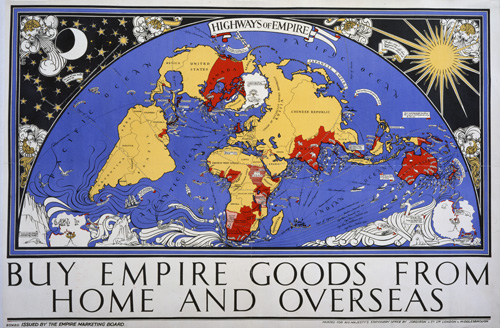 'Highways of Empire' (TNA) CO956-537A
'Highways of Empire' (TNA) CO956-537A
Article 2: The Empire Marketing Board
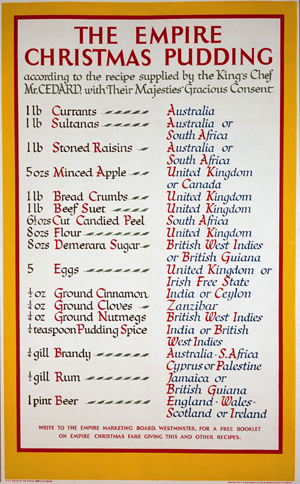 'The Empire Christmas Pudding', by F.C. Harrison; 25 ins x 40 ins, displayed November-December 1928; Roberts and Lete Ltd, London; EMB ref A02; (TNA) CO956/63
'The Empire Christmas Pudding', by F.C. Harrison; 25 ins x 40 ins, displayed November-December 1928; Roberts and Lete Ltd, London; EMB ref A02; (TNA) CO956/63
The Empire Marketing Board (EMB) looks at the origins and role of one iconic Empire marketing institution. The EMB was founded in May 1926 to encourage Empire trade, and was given committees for research, marketing and publicity.
In reality, it spent as much money on research as publicity, but it was the latter which lodged in the public mind. In its six-year life, it unleashed millions of posters, from a few gigantic billboard features, such as Highways of Empire (shown above, 1927), through cheap, reduced-size copies sent to thousands of schools and sold to the pubic, to miniature versions that you could stick on your car window.
To appease home producers, the EMB also publicised British and Irish produce. In 1931, it ran a massive ‘Buy British’ campaign. The EMB’s message in and beyond this campaign was to buy British first, Empire second and foreign last. The Empire, it argued, was Britain’s best market, so money spent there would support British jobs as well.
Above all, the EMB portrayed the entire Empire as a family, with the housewife building Empire through her shopping choices.
The poster was followed in 1930 by a film on the same theme, entitled One Family (69 minutes). That film is in turn discussed in more detail in Article 4: Film. The Board was dissolved in September 1933, following the introduction of ‘Imperial Preference’ (charging a tariff on foreign goods, but less or none on their Empire counterparts).
Article 3: Posters
Posters discusses the Empire Marketing Board’s posters in more detail, starting with the Highways of Empire poster shown above.
Article 4: Film
Film shows how EMB filmmakers were given enormous scope to experiment. It traces how this allowed them to progress from cheaply shot shorts on British topics to innovative films such as Out of Ceylon. The EMB was abolished at the end of September 1933, but Film Unit members joined other important bodies, and so continued to make important contributions to the British documentary tradition and to wartime propaganda.
Article 5: Epilogue – the slow death of heroism?
Epilogue: the slow death of heroism?, traces the change from optimism over the Commonwealth and over Britain as a jet-age great power in the 1940s-50s, towards comedy and cynicism over Empire by the 1960s. Starting with the Empire and Commonwealth Annuals of the early postwar years, it ends with Carry on Up the Khyber and the Flashman novels.
Other ways Empire was marketed
Inevitably, these articles are no more than a taster for the innumerable ways Empire has been sold, from music hall songs to the sets of cards given away with cigarettes and tea packets from the late 1880s.
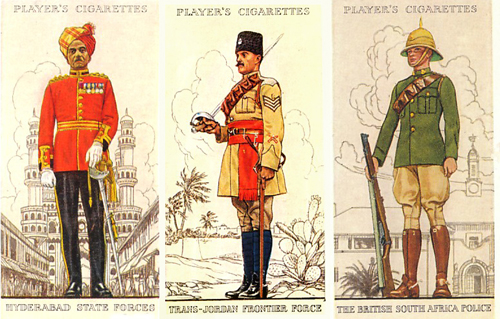 Three cards from the 'Military Uniforms of the British Empire' series of John Player and Sons cigarette cards (branch of the Imperial Tobacco Co. of Great Britain and Ireland Ltd), 1938
Three cards from the 'Military Uniforms of the British Empire' series of John Player and Sons cigarette cards (branch of the Imperial Tobacco Co. of Great Britain and Ireland Ltd), 1938
At the same time, a myriad of private companies were marketing themselves as able to bind Britain and Empire together, as in the 1930s to 1950s advertisements below.
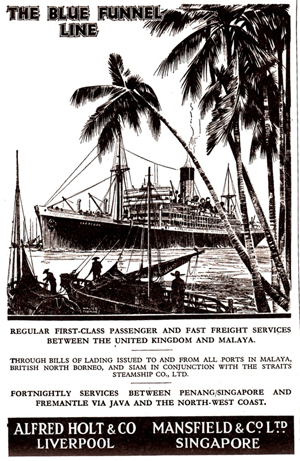 Pre-war advertisement for The Blue Funnel Line in Times Weekly Edition (Special Singapore Naval Base Number), Thu 3 March, 1938, p. 30
Pre-war advertisement for The Blue Funnel Line in Times Weekly Edition (Special Singapore Naval Base Number), Thu 3 March, 1938, p. 30
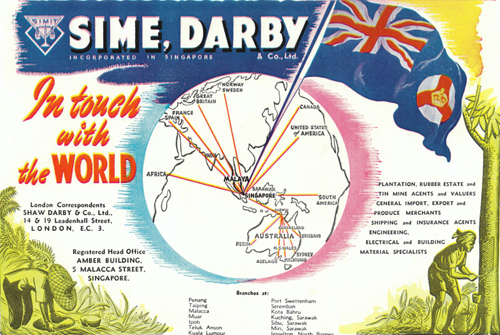 Sime, Darby advertisement from Straits Times Annual (Singapore); precise dates unknown but circa 1940s/50s
Sime, Darby advertisement from Straits Times Annual (Singapore); precise dates unknown but circa 1940s/50s






Rate and Review
Rate this article
Review this article
Log into OpenLearn to leave reviews and join in the conversation.
Article reviews